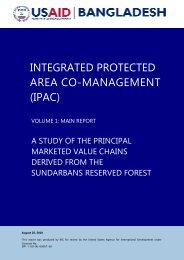Child Equity Atlas - BIDS
Child Equity Atlas - BIDS
Child Equity Atlas - BIDS
Create successful ePaper yourself
Turn your PDF publications into a flip-book with our unique Google optimized e-Paper software.
<strong>Child</strong> <strong>Equity</strong> <strong>Atlas</strong><br />
to 2.2 (2012) in Bangladesh; an enviable feat that<br />
sets the stage for reaping demographic dividends<br />
into national growth and equitable socioeconomic<br />
development, if counter balanced with educational<br />
attainment, age of marriage and other variables<br />
that contribute to productive human capital and<br />
dependency.<br />
2.1.1 Teenage marriage hurts the health and could<br />
halt the development of girls in several ways.<br />
The early pregnancy that often follows teenage<br />
marriage compromises the health of young girls<br />
as well as the nutritional well-being of babies<br />
born in such circumstances. Caring for young<br />
mothers and their newborn babies poses obvious<br />
challenges in terms of capacities and resources<br />
for families as well as the health delivery system.<br />
Additionally, teenage marriage particularly among<br />
girls is a barrier to their educational attainment<br />
(see chapter three).<br />
2.1.2 In the Bangladesh Population Census it was<br />
estimated that 32.5 per cent of girls (15-19 years)<br />
were married in 2011, compared with 37.5 per<br />
cent in 2001. The practice of teenage marriage has<br />
reduced by a mere five percentage points over the<br />
last decade, a very slow pace compared to other<br />
demographic parameters in Bangladesh.<br />
2.1.3 Bangladesh has a very high population<br />
density - 968 persons per square kilometre -<br />
unevenly distributed across the country and<br />
posing a challenge for civic authorities to provide<br />
basic facilities such as drinking water and<br />
sanitation where spatial limitations of land and<br />
population pressure impact one another.<br />
2.1.4 The wide range of population density from<br />
Dhaka district having 8,229 persons per square<br />
kilometer to Bandarban with 87 people sharing<br />
the same area of land, which is further interspersed<br />
by numerous roads and rivers (Map 2.1), reveals<br />
the physical infrastructure of the country. The<br />
population density in the highest and lowest five<br />
districts is presented in Table 2.1 below. There are<br />
about 95 times more people per square kilometre<br />
in Dhaka than in Bandarban, posing challenges for<br />
infrastructure and social services being provided<br />
for the population. Population density by district<br />
and upazila are presented in Maps 2.2 and 2.3<br />
respectively with a deeper colour in the Map<br />
depicting higher levels of density. The Map shows<br />
that the density of population is relatively higher<br />
in the central parts and lower in the char, haor and<br />
coastal areas, and hill tracts of the country.<br />
Table 2.1: Population density (population/<br />
sq.km.): Lowest and highest density districts,<br />
Bangladesh 2011<br />
Srl.<br />
Low density districts<br />
District<br />
Population<br />
density<br />
High density districts<br />
District<br />
Population<br />
density<br />
1. Bandarban 87 Dhaka 8229<br />
2. Rangamati 97 Narayanganj 4308<br />
3. Khagrachhari 223 Narsingdi 1934<br />
4. Bagerhat 373 Gazipur 1884<br />
5. Patuakhali 477 Comilla 1712<br />
Bangladesh: 968<br />
Photo : Ibrahim Khan Moni<br />
14














